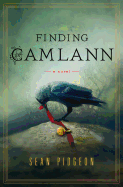
What's Camlann, you ask? It's where King Arthur fought and died, run through by his enemy Mordred's sword. That's what the legend tells us, but no one is sure where Camlann is. Debut novelist Sean Pidgeon approaches the subject from a different angle in Finding Camlann. It's part love story, part literary suspense, part archeology quest... but all Welsh.
Archeologist Donald Gladstone hopes to publish a book about the "real" Arthur, as revealed in the literary and historical record. He hears news of an exciting archeological discovery at Devil's Barrow near Stonehenge--bones of ancient fighters and a "magical chalice" that might be the Holy Grail. Could it be the burial site for Arthur and Guinevere? Add to this his discovery of an old Welsh poem about Arthur that seems to contain a geographical reference to the Barrow. Then add Julia Llewellyn, who works at the Oxford English Dictionary and is fluent in Old and Middle Welsh. Pidgeon weaves an intricate tale drawing on literature, dusty manuscripts and variant translations of ancient texts. Then there's the geography of Wales, which plays a significant role in the novel, as does the historical undercurrent of Welsh hatred for all things English. There's also a mysterious group of militant Welsh nationalists, to which Hugh may belong.
Finding Camlann shares plot elements similar to those of a Dan Brown novel, but it's more like Umberto Eco's The Name of the Rose in terms of the serious, sometimes arcane way it involves the reader in scholarly and historical matters. Although the romance part of Pidgeon's tale doesn't quite catch fire, readers interested in a thoughtful mystery with strong literary underpinnings will enjoy the bookish puzzles hidden within. --Tom Lavoie, former publisher

